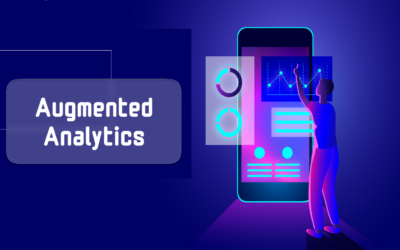7 Ways Smart Data Can Reduce Business Costs

Introduction
In today’s digital age, data is the new currency of business success. Harnessing the power of smart data can significantly impact a company’s bottom line by identifying opportunities for cost savings and efficiency improvements.
Smart technology is everywhere in our lives today. We’ve got smart gadgets like phones, speakers, and cars, along with a whole bunch of other smart devices connected through the Internet of Things (IoT). They’re all designed to make things easier and more intuitive for us. Even the data businesses use can be smart. When they use business intelligence tools, they can turn piles of information into smart data. Instead of spending hours searching for what they need, they can just run everything through software and get a report with the most important details.
About 80% of companies worry about handling the huge amounts of data from the IoT and making sense of it all. That’s where smart data comes in. It’s about turning big data into useful information tailored to each business’s needs.
For business owners, using smart data has a big perk: it helps cut costs. Breaking down data into management reports saves companies money in various ways. In this blog post, we’ll explore seven ways smart data can help reduce business costs and boost profitability.
7 Smart Ways of Data to Analyse Cost Reduction
- Avoid Costly Mistakes
- Reduce Employee Churn
- Reduce Fleet Costs
- Outsmart the Competition
- Boost Productivity
- Track Inventory
- Reduce Energy Usage
1. Avoid Costly Mistakes
Utilizing smart data analytics enables businesses to identify and mitigate potential errors before they occur, preventing costly mistakes. By analyzing historical data and patterns, businesses gain insights into potential risks and inefficiencies in processes, operations, and decision-making.
This proactive approach not only saves money but also safeguards the company’s reputation and enhances customer satisfaction. Implementing smart data solutions empowers businesses to make informed decisions, anticipate challenges, and take preventive measures, ultimately minimizing financial losses associated with errors and ensuring smoother operations.
Real-time example: An e-commerce platform uses smart data to analyze user behaviour and identify potential checkout process bottlenecks. By proactively addressing these issues, they prevent cart abandonment and boost conversion rates, avoiding revenue losses.
2. Reduce Employee Churn
Employee turnover can incur significant expenses for businesses, including recruitment, training, and lost productivity. Smart data analytics offers insights into the underlying causes of employee churn, such as dissatisfaction or lack of engagement. By identifying these factors, businesses can implement targeted retention strategies to reduce turnover rates.
These strategies may include improving workplace culture, offering competitive compensation packages, or providing opportunities for career development. By addressing the root causes of employee turnover, businesses can lower recruitment costs, retain valuable talent, and foster a more stable and productive workforce.
Best example: A tech company analyzes employee feedback and performance data to identify areas of dissatisfaction. They implement targeted initiatives, such as flexible work arrangements or professional development opportunities, reducing turnover rates and retaining top talent.
3. Reduce Fleet Costs
For businesses with a fleet of vehicles, optimizing routes and maintenance schedules is essential for minimizing costs. Smart data analytics analyzes factors like traffic patterns, fuel efficiency, and vehicle maintenance needs to optimize fleet operations. By identifying the most efficient routes and scheduling timely maintenance, businesses can reduce fuel consumption, maintenance expenses, and overall fleet costs.
Additionally, real-time monitoring of fleet performance allows for proactive decision-making, such as rerouting to avoid traffic congestion or addressing mechanical issues promptly. These data-driven optimizations not only save money but also improve operational efficiency and customer satisfaction.
Coating an example: A delivery company utilizes GPS tracking and route optimization software to minimize fuel consumption and vehicle wear. Optimizing routes in real-time based on traffic conditions reduces fuel expenses and maintenance costs.
4. Outsmart the Competition
In today’s competitive market, staying ahead of rivals is crucial for business success. Smart data analytics provides insights into market trends, consumer behaviour, and competitor strategies, enabling businesses to make informed decisions and innovate proactively. By leveraging this data, companies can identify emerging trends, anticipate competitor moves, and differentiate themselves in the market.
Whether through product innovation, marketing strategies, or customer experience enhancements, businesses can outsmart the competition and gain a competitive edge. By staying ahead of market dynamics and consumer preferences, companies can maintain relevance, attract customers, and sustain long-term profitability.
Suitable example: A retail chain uses smart data to monitor competitor pricing and consumer trends. They adjust their pricing strategy in real-time to remain competitive, attracting more customers and increasing market share.
5. Boost Productivity
Improving productivity is a key driver of cost reduction and profitability for businesses. Smart data analytics identifies inefficiencies, bottlenecks, and opportunities for process optimization within an organization. By streamlining workflows, automating repetitive tasks, and reallocating resources based on data-driven insights, businesses can boost productivity and reduce labour costs.
Additionally, predictive analytics can anticipate demand fluctuations, enabling businesses to adjust staffing levels and production schedules accordingly. By maximizing operational efficiency and resource utilization, companies can achieve more with fewer resources, enhance competitiveness, and drive sustainable growth.
Example: A manufacturing plant implements IoT sensors to monitor equipment performance and predict maintenance needs. By preemptively addressing potential breakdowns, they minimize downtime and maximize production efficiency, boosting overall productivity.
6. Track Inventory
Effective inventory management is essential for minimizing costs and optimizing supply chain operations. Smart data analytics provides real-time visibility into inventory levels, demand patterns, and supply chain performance. By accurately forecasting demand, optimizing reorder points, and identifying slow-moving or obsolete inventory, businesses can reduce holding costs and improve cash flow.
Additionally, data-driven insights enable proactive inventory management, such as identifying trends or seasonality patterns to adjust procurement and production schedules accordingly. By optimizing inventory levels and reducing stockouts or overstock situations, businesses can enhance customer satisfaction, minimize carrying costs, and improve overall supply chain efficiency.
Real-time example: A supermarket chain employs RFID technology to track inventory levels in real time. By automating stock replenishment and minimizing overstock situations, they optimize inventory management, reduce holding costs, and ensure product availability for customers.
7. Reduce Energy Usage
Energy costs can represent a significant expense for businesses, particularly those with large facilities or energy-intensive operations. Smart data analytics helps identify opportunities for energy savings by analyzing consumption patterns, identifying areas of inefficiency, and recommending energy conservation measures. Whether through upgrading equipment, implementing energy-efficient technologies, or optimizing building systems, businesses can reduce energy consumption and lower utility bills.
Additionally, real-time monitoring and predictive analytics enable proactive energy management, such as adjusting usage patterns or identifying equipment malfunctions early to prevent wastage. By reducing energy usage and environmental footprint, companies can lower operating costs, enhance sustainability, and demonstrate corporate responsibility.
Appropriate example: A commercial building installs smart thermostats and lighting systems that adjust based on occupancy and natural light levels. By optimizing energy usage in real-time, they lower utility bills and reduce environmental impact without sacrificing comfort or productivity.
Develop a Big Data Strategy
To harness the full potential of smart data for cost reduction, businesses need to develop a comprehensive big data strategy. This strategy should outline objectives, data sources, analytics tools, and implementation plans.
It’s essential to invest in the right technology infrastructure, data governance processes, and talent to effectively collect, analyze, and leverage data insights. By aligning their big data strategy with business goals, companies can maximize the value of smart data and drive sustainable cost savings over time.
Conclusion
In conclusion, smart data is a powerful tool for reducing business costs and improving profitability across various areas of operation. By avoiding costly mistakes, reducing employee churn, optimizing fleet operations, outsmarting the competition, boosting productivity, tracking inventory effectively, and reducing energy usage, businesses can achieve significant cost savings and enhance their competitive advantage.
However, to unlock the full potential of smart data, companies must develop a robust big data strategy and invest in the necessary resources and capabilities. By embracing data-driven decision-making, businesses can drive sustainable cost reduction initiatives and thrive in today’s dynamic business environment.
Are you looking for any IT Services such as Software Testing, Web design and Development, Professional/Staff Augmentation Services, Cloud Computing, Mobile App Development, Digital Marketing Services and more? Connect Stridefuture Technology, which helps to meet your requirements.
{StrideFuture Technology, a full-service company specializing in Software Solutions and Consultancy services. We specialize in Personal, Business, IT Services, Software Testing, Web design and Development, Mobile App Development, Digital Marketing Services, and much more you can dream Virtually with us! Reach out for more service at StrideFuture Technology.}









